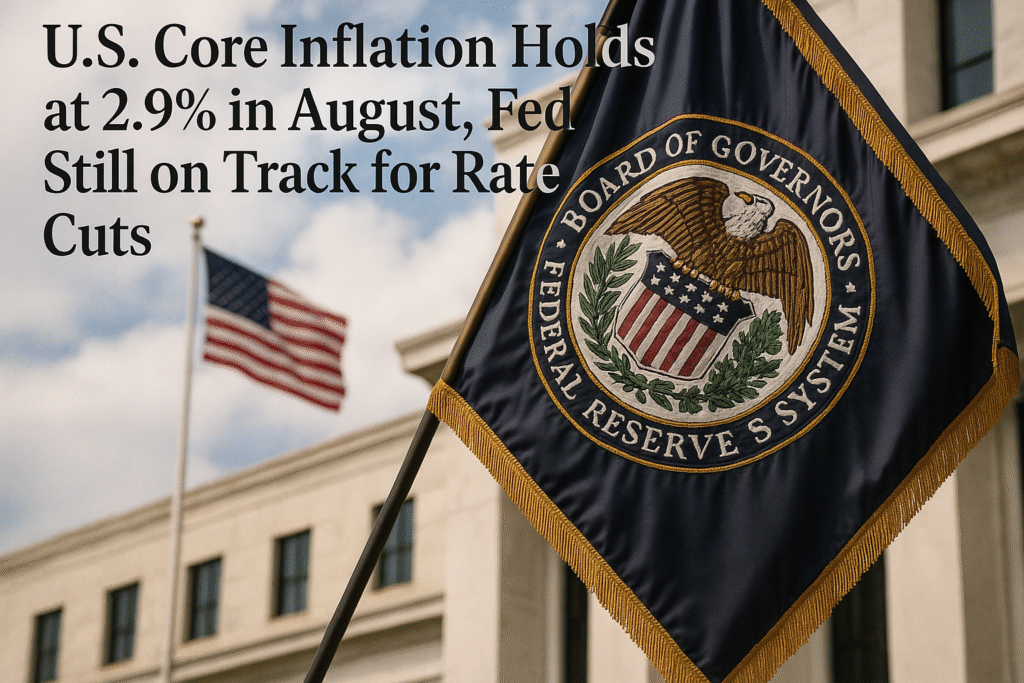By Harshit, Washington D.C., September 26, 2025 — 8:45 AM ETD
Inflation in the United States remained steady in August, according to the Federal Reserve’s preferred gauge, reinforcing expectations that policymakers will move ahead with two more interest rate cuts before the end of the year.
Inflation Data: In Line with Forecasts
The Commerce Department reported Friday that the personal consumption expenditures (PCE) price index, a key measure of inflation, rose 0.3% in August, placing the annual headline rate at 2.7%. Excluding food and energy, the core PCE index increased 0.2% for the month and 2.9% year over year.
The readings matched consensus forecasts and suggested that inflationary pressures remain contained despite lingering concerns about tariffs and global supply chain disruptions. The annual core rate was unchanged from July, while the headline rate edged slightly higher from 2.6%.
Spending and Income: Stronger Than Expected
Personal income rose 0.4% in August, slightly above expectations. At the same time, consumer spending accelerated by 0.6%, also beating forecasts. The personal saving rate ticked up to 4.6%, a 0.2 percentage point increase from the prior month.
“Net, net, consumers literally hit it out of the park with very strong gains in spending not just for August, but June and July as well,” said Chris Rupkey, chief economist at Fwdbonds. He described the summer as a period of “consumer revenge spending” after months of cautious behavior tied to tariff uncertainties earlier in the year.
The data showed that goods prices increased 0.1% in August, while services rose 0.3%. Food costs climbed 0.5%, energy goods and services jumped 0.8%, and housing costs posted a 0.4% gain.
Federal Reserve Outlook: Rate Cuts Expected
The Federal Reserve targets inflation at 2%, and though current readings are above that level, policymakers have signaled they expect inflation to moderate. Last week, Fed officials indicated that they see room for two more quarter-point reductions before year’s end.
Markets strongly anticipate a rate cut at the October meeting, with somewhat less confidence in a December move. The Fed already lowered its benchmark interest rate by 0.25 percentage points earlier this month, bringing the federal funds rate to a range of 4.0% to 4.25%—the first easing of the year.
Fed Chair Jerome Powell and other policymakers have suggested that tariff-related price increases are likely to represent a temporary, one-time boost rather than a sustained source of inflation. However, some officials have expressed reservations, citing limited scope for aggressive rate cuts without risking long-term financial stability.
Tariffs and Consumer Resilience
The report also indicated that President Donald Trump’s tariffs have had only a limited pass-through effect on consumer prices. Despite widespread expectations that higher import levies would feed directly into inflation, many companies have offset the impact through inventory buildup and cost-absorbing strategies.
So far, consumers have proved resilient. Spending has held up despite higher prices in areas such as food, energy, and housing. Analysts say the combination of steady income growth and rising savings indicates that household demand remains a key driver of the U.S. economy.
Market Reaction: Gains in Equities, Lower Yields
Stock market futures extended gains following the release of the inflation report, while Treasury yields edged lower. Investors interpreted the data as supportive of further monetary easing without signaling runaway inflation risks.
“The inflation numbers keep the Fed on its path for easing, while strong consumer spending provides reassurance about economic growth,” said a New York-based market strategist. “It’s a sweet spot for markets in the short term.”
Outlook: Balancing Risks
Economists say the August data underscores the delicate balance facing the Fed. On one hand, consumer resilience and manageable inflation support gradual easing. On the other, uncertainty about tariffs, global growth, and longer-term inflation trends suggest caution.
For now, markets remain confident that the Fed will deliver at least one more rate cut before year-end, with the October meeting viewed as the most likely window.







